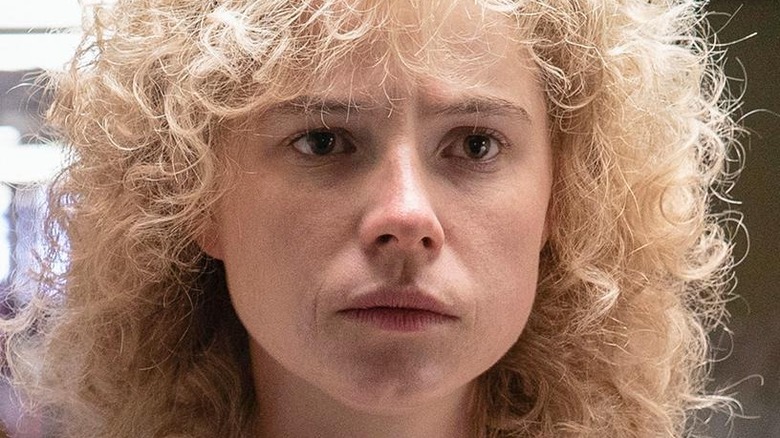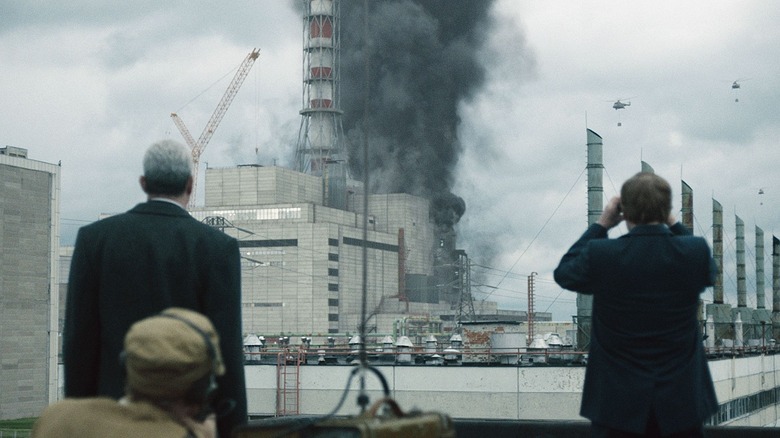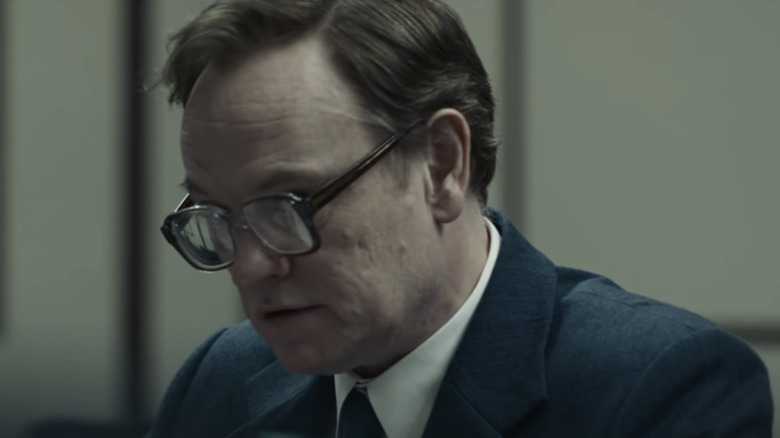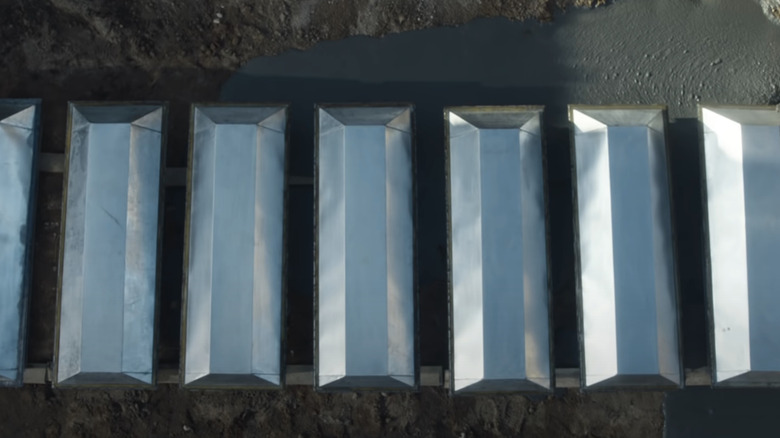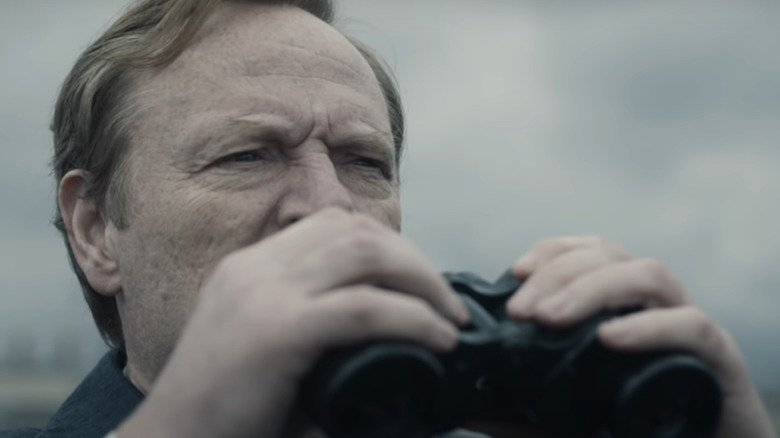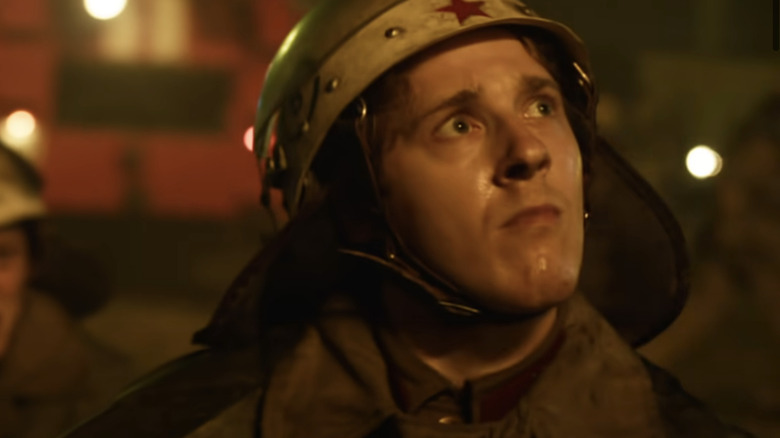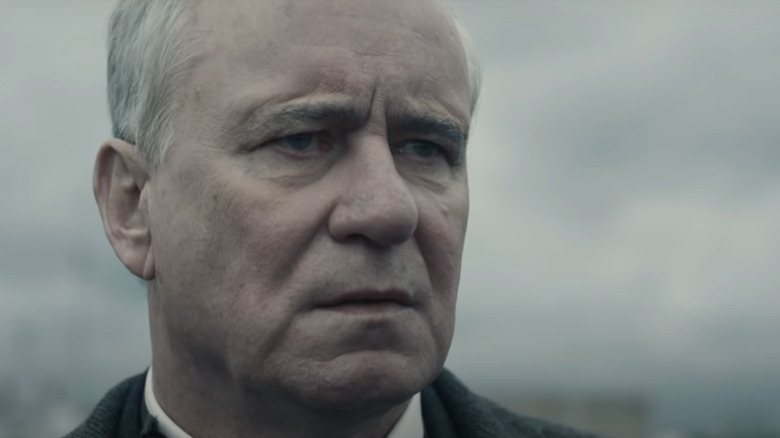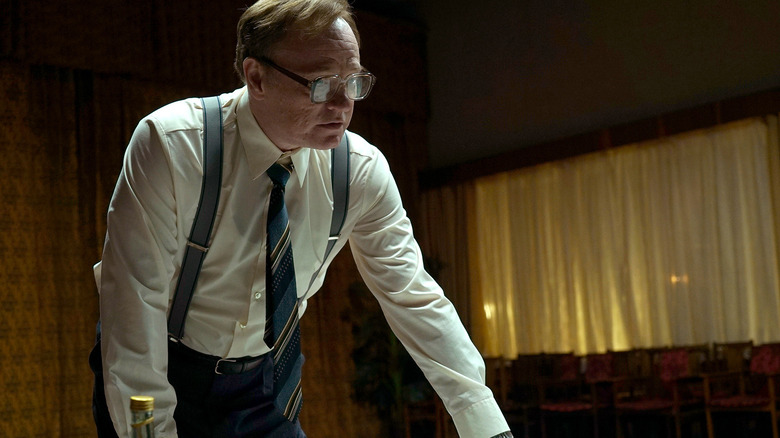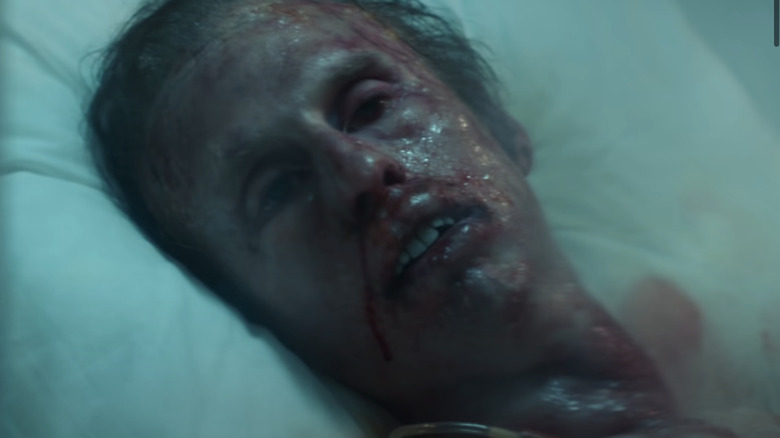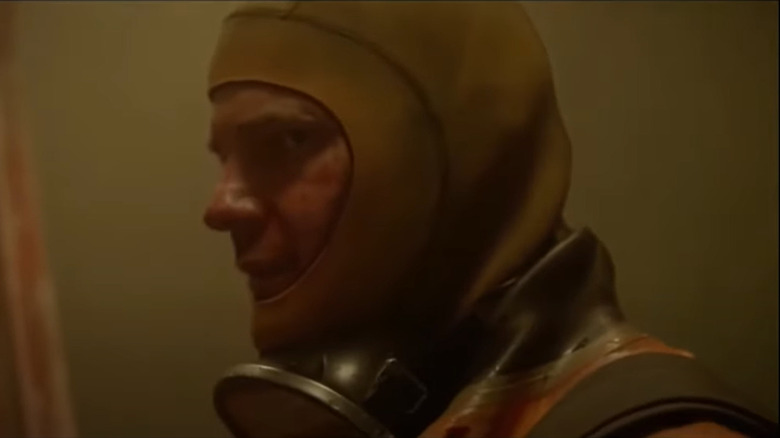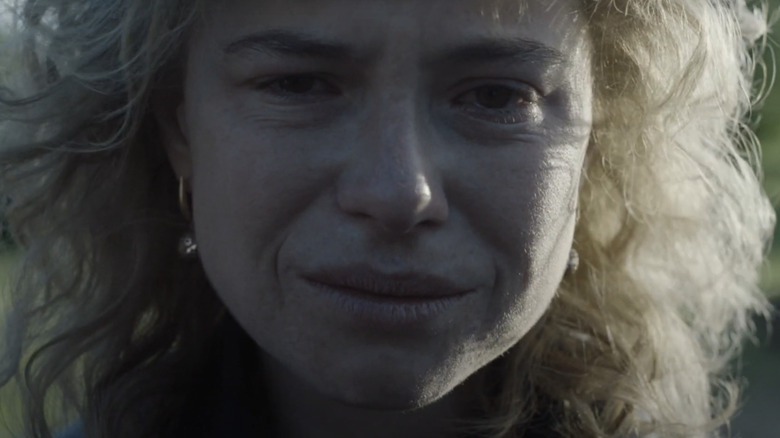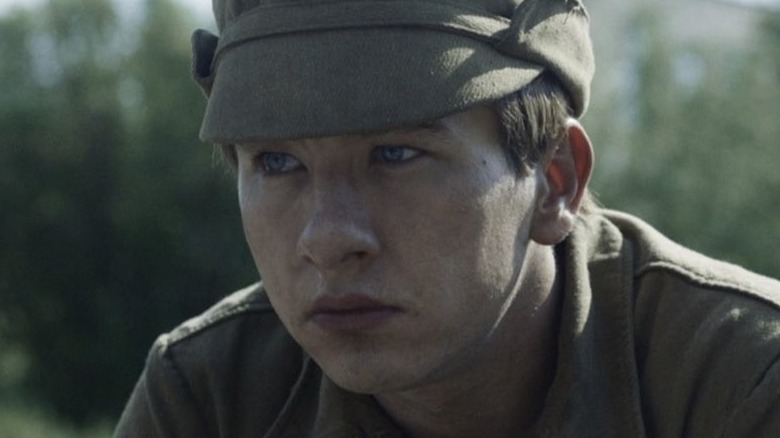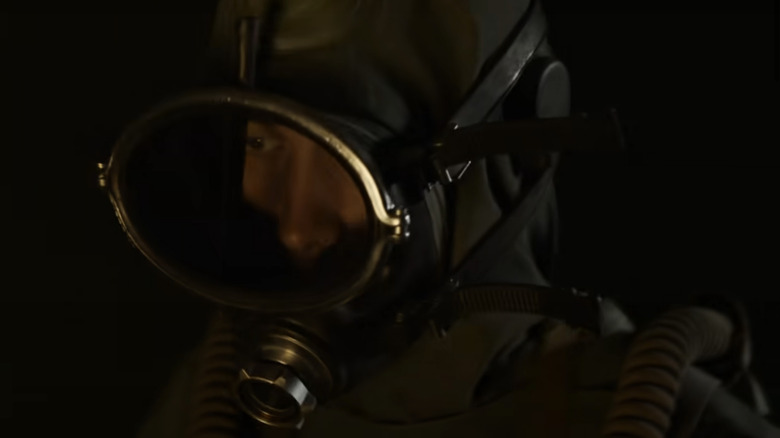Chernobyl's 12 Most Disturbing Scenes Ranked
In 2019, a miniseries hit HBO that was quickly crowned the bleakest television event of the year. That miniseries was "Chernobyl," a five-part show written by Craig Mazin and directed by Johan Renck that chronicles the infamous, catastrophic, and world-changing nuclear meltdown of the Chernobyl Nuclear Power Plant in the city of Pripyat, Ukraine in 1986.
Not only was the Chernobyl disaster responsible for thousands of deaths, it's also one of the most staggering examples of government malpractice in recent history. In response to radiation that was equivalent to 500 Hiroshima bombs, Soviet Union officials failed to order an evacuation of the immediate areas and blatantly withheld information about the terrifying and deadly situation at hand to residents and to soldiers tasked with cleaning up the fallout.
Presented with sobering realism, "Chernobyl" unflinchingly portrays both the fatal corruption of the government and the horrific first-hand realities of the accident. Because of this, it is undoubtedly one of the most terrifying shows in recent history. Here are its 12 most disturbing scenes.
A chilling blue streak
When the Chernobyl meltdown first occurred, many people had no idea what was going on or how serious the situation really was. In Episode 2 of "Chernobyl," "Please Remain Calm," there is one tell-tale sign of impending disaster that will fill any viewer with dread and send chills down their spine. To illustrate the severity of the meltdown to the skeptical Council of Ministers' Deputy Chairman Boris Shcherbina (Stellan Skarsgård), chemist Valery Legasov (Jared Harris) points to one thing — a single blue streak.
What's so scary about a blue streak, you might ask? In his account of the accident, a Chernobyl worker Alexander Yuvchenko explained that he knew something was deeply wrong when, on the night of the incident, he "ran out of the building and saw half of the building gone and the reactor emitting a blue glow of ionized air." This glow indicates that the reactor is completely exposed and is therefore shooting deadly radiation straight into the unprotected atmosphere. This simple image in "Chernobyl" is a poignant symbol that something is really, really wrong. Who knew a blue beam could be one of the most disturbing images that TV has to offer?
Valery hangs himself
One of the most disturbing moments in all of "Chernobyl" is its first scene. The show starts with Valery Legasov hanging himself after recording some memoirs. Of course, it's always unnerving to watch someone take their own life, no matter the circumstances. But this scene becomes increasingly horrifying as the show progresses and it becomes clear exactly why he hanged himself. Not only is he traumatized by the brutalities he's witnessed, but after warning the government about the dangers of the radioactive air and watching them ignore it for a long time — allowing countless people to die slow, horrible deaths — he feels responsible.
What's even more chilling about this moment is the fact that Legasov was actually a real person. While some people theorized that Legasov killed himself due to radiation poisoning accrued while investigating Chernobyl, his daughter, quoted in "Academian Valera," stated "It was not an emotional breakdown, it was a deliberate, well-weighed action."
If you or anyone you know is having suicidal thoughts, please call the National Suicide Prevention Lifeline by dialing 988 or by calling 1-800-273-TALK (8255).
Zinc coffins
One of the lesser-known facts about the Chernobyl disaster is that many of the people who died of radiation poisoning after the fact had to be buried in zinc coffins encased in concrete. This is because their bodies were so poisonous that they could harm others if not buried correctly; even still, these cemeteries aren't considered completely safe to visit to this day. The exposure that so many first responders had to the radiation was so intense, in fact, that their bodies often shriveled up to around 40 kilograms, or roughly less than 90 pounds.
In the third episode of "Chernobyl," "Open Wide, O Earth," a pregnant woman named Lyudmilla (Jessie Buckley) experiences this burial method firsthand when her firefighter husband and many others are somberly lowered into the ground. It is a sobering moment to say the least, as it reminds the viewer of just how much toxicity so many people were exposed to during this time.
Government corruption
One of the main things that makes "Chernobyl" such a sobering, unsettling watch is the realization that a lot of deaths occurred because the government failed to act in accordance with the severity of the situation. When Valery first arrives on the scene of the crime, he insists to Boris that what's happening is a big deal. But Boris ignores him — even after seeing the giant radiation beam and ominous fire with his own eyes.
The scene in Episode 2, "Please Remain Calm" when Valery fails to convince Boris of the danger that all of Europe is currently in is easily one of the most horrifying scenes in "Chernobyl." This is because it reminds us that a lot of suffering and death could have been prevented.
Eventually, the government comes to realize that Valery was right all along. In Episode 5, "Vichnaya Pamyat," Plant Director Viktor Bryukhanov (Con O'Neill), and Chief Engineer Nikolai Fomin (Adrian Rawlins) are put on trial for how they handled the disaster. During the trial, Valery blames the government for the horrific fallout, explaining that the Boron control rods inside of the plant, which were supposedly used to put out the fire, were tipped with graphite which causes further reactivity. This was all because graphite was cheaper than a material that would've been effective.
The Chernobyl meltdown
Unsurprisingly, in a show about a horrible disaster, the scene where the disaster actually takes place is bound to be one of the scariest. This is certainly true in "Chernobyl," which waits until the very end to allow the horrific meltdown scene to play out in full. This scene is edited in between Valery's testimony of the government mishandling of the event, which makes it even more grim because it reminds the viewer that it could have been prevented.
The scene emphasizes just how terrifying the moment must have been for those working in the plant by using close-ups on shaking hands, expressions of panic and despair, and the radiation reader quickly increasing like a ticking time bomb. There is a lot of build-up to the actual explosion, which makes that moment extremely shocking, jarring, and disturbing. This is followed by the most shocking reveal of all — the workers had no idea that the shutdown button doubled as a detonator.
A melted helicopter blade
Some of the most disturbing scenes in "Chernobyl" are the ones where the viewer sees exactly how powerful the radiation from the meltdown truly is. It's pretty common knowledge that radiation has a pretty dismal effect on the human bodies, but the show establishes pretty early on that machines are no match for radiation, either. In a desperate attempt to put out Chernobyl's initial fire, the government orders the military to drop a mix of sand and Boron on it from above.
Valery warns them not to fly directly over the fire, as that will have potentially dire effects on both the helicopter and its passengers. One of the pilots disregards his orders, however, and flies right over the flames, which quickly causes the helicopter to crash, and one of its blades to nearly disintegrate. This illustrates the sheer, horrifying force of the radiation in the air during that time.
Though this is undoubtedly a scary scene in the show, it's also not entirely accurate. No helicopter actually crashed while attempting to put out the Chernobyl fire, but some pilots who flew near the reactor suffered dire consequences. In 1990, Soviet helicopter pilot Anatoly Grishchenko died from leukemia at 53, a common long-term effect of radiation sickness.
A horrifying ripple-effect
After the Chernobyl explosion, Valery informs his peers just how many people the radiation could affect. He explains that the reactor "will burn and spread its poison until the entire continent is dead." He continues, stating that this is an event that has never before occurred in the history of mankind. These words are just as likely to send chills down a viewer's spine as any gory image.
Thankfully, scientists and military personnel were able to prevent that from happening to such a dramatic extent, but that doesn't mean that the poison didn't spread horrifyingly far due to unpredictable factors such as rain and wind. Two days after the explosion, for example, radioactive particles were found in Sweden, which is a whopping 683 miles away from Ukraine. According to the World Nuclear Association, "Most of the released material was deposited close by as dust and debris, but the lighter material was carried by wind over Ukraine, Belarus, Russia, and to some extent over Scandinavia and Europe."
Vasily's face
One of the most disturbing and tragic storylines in all of "Chernobyl" is the relationship between Lyudmilla and her husband, Chernobyl first-responder Vasily Ignatenko (Adam Nagaitis). After the explosion, Vasily and his co-workers are sent to the hospital for what Lyudmilla thinks are just regular burns. But then she watches him deteriorate in front of her very eyes, resulting in one of the most disturbing scenes in the entire show, in which Lyudmilla bribes a nurse to let her see her husband on his deathbed.
When she gets there, her husband's face is practically melted off and he is mostly despondent. What is even more horrifying about this scene is that the Lyudmilla and Vasily of "Chernobyl" are based on real people. In Svetlana Alexievich's "Voices from Chernobyl," the real Lyudmilla Ignatenko recounts her husband's deterioration, explaining that "He started to change; every day I met a brand-new person. The burns started to come to the surface. In his mouth, on his tongue, his cheeks — at first there were little lesions, and then they grew. It came off in layers — as white film ... the colour of his face ... his body ... blue, red, grey-brown." Tragically, Vasily died just two weeks after he visited Chernobyl.
Radioactive water
When it comes to putting out Chernobyl's fire, one problem just leads to another. After the military agrees to put it out using Boron and sand, they learn that contact with the plant's water valve and the mixture will lead to a steam explosion of epic and fatal proportions. The only way to fix this problem is for divers to swim through the reactor and drain the water. Who wouldn't want to do that?
The swimmers are able to drain the water in the nick of time, but the scene itself is relentlessly terrifying and tense. The men carry clickers which notify them when they are getting too close to radiation, and that sound getting faster and faster is like a ticking time-bomb.
One character in "Chernobyl" predicts that if the steam explosion had actually gone off, it would have been catastrophic, blasting megatons of Trinitrotoluene (a compound commonly referred to as TNT) into the atmosphere. Some scientists suggest that this metric was exaggerated for dramatic effect, and that only around 149 tons of TNT would have been released. Regardless, a lot of damage could be done by that metric, so either way, we can count our lucky stars for the heroic divers.
Lyudmilla's stillbirth
One of the most heartbreaking moments in all of "Chernobyl" takes place at the end of Episode 4, "The Happiness of All Mankind," when we learn that Lyudmilla's newborn baby girl only lived for a couple of hours before dying of radiation poisoning. The fetus was presumably poisoned when Lyudmilla hugged her husband while he was hospitalized, as a large amount of radiation transferred from Vasily to his unborn baby.
This is a heartbreaking scene, not only because she loses her baby, but also because she lost her husband just before. To make it even more emotional, Jessie Buckley brings a subtle yet powerful performance to the table, wordlessly conveying the weight of the tragedy she has undergone.
"Chernobyl" was one of Buckley's first big roles, and quickly catapulted her into well-deserved stardom. Since then, she has appeared in a number of popular films, such as Charlie Kaufman's "I'm Thinking of Ending Things," FX's TV series "Fargo," Maggie Gyllenhaal's "The Lost Daughter," and Alex Garland's horror film "Men."
The dogs
There are many people who will, understandably, avoid any film or TV show that shows an animal being harmed. Those people should steer far, far away from "Chernobyl." In Episode 4, troops are sent into the newly devised evacuation zone. Their mission? Get rid of any wild animal roaming around, for fear that they will spread radiation outside of the quarantine zone.
This segment of the episode is just as disturbing and hard to watch as it sounds. Many dogs are killed, and even the most cold-hearted person will have a hard time watching that. What makes this even more difficult to watch is that it is 100% accurate. After the episode aired, Mazin wrote that the events of the episode "happened. And we toned it down from the full story." He continued "War leaves all kinds of scars. These were the things men were ordered to do."
An animal welfare organization called SPCA International backed this up, explaining that, when thousands of people were forced to evacuate Chernobyl, they didn't have the chance to bring their dogs and cats with them. And after they left, they weren't able to come back for their pets.
But it's not all bad. SPCA is committed to taking care of the animals that remain in Chernobyl — of which there are a lot. They even found that a lot of them don't have a dangerous amount of radiation in them and are therefore able to exit the zone and find a happy life elsewhere.
Clearing graphite
By far the most disturbing scene in HBO's "Chernobyl" also takes place in Episode 4. In this episode, troops are ordered to clear graphite off of the roof of the plant, but due to the intense levels of radiation, they can only stay up there for 90 seconds. This makes for a horrific and tense scene, which is hard to watch because the viewer knows by now that anyone who gets that close to the radiation is bound to die from poisoning.
An even tougher pill to swallow is the knowledge that the men were ordered to do this so that the government could avoid humiliation after a reading showed that the radiation on the roof was 12,000 roentgen, as opposed to the previously reported 2,000. According to Jaan Krinal, a real man who shoveled radioactive debris off of the roof, he and his peers had no idea how much danger they were in at the time, and the officials told the workers that Chernobyl was "just a minor accident, nothing to worry about." In retrospect, that couldn't have been farther from the truth.
